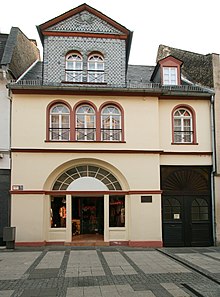Synagogue (Eltville am Rhein)
The Eltviller synagogue was up to the Kristallnacht 1938 the synagogues of the Jewish community in Eltville .
history
The Israelite community of Eltville, which also included the Jews of Oestrich , Erbach , Hattenheim , Neudorf , Rauenthal , Kiedrich , and Upper and Lower Walluf , belonged to the rabbinical district of Wiesbaden . There was already a synagogue in the house of Enoch Abraham in 1780, but nothing is known about its location today.
Israel Mayer, an "Eltville trading Jew" who had already set up a Jewish bath in the courtyard of his house , bought another house in Holzgasse 179 (today Schwalbacher Strasse 3) in 1830 and donated it to the Israelite community. After being converted into a synagogue, it was inaugurated in 1831 (according to the plaque in 1832). This had 44 men and 30 women places. Due to its small size, the Eltville congregation did not have its own rabbi , and from 1843 there was not even a service at times, as the Jews from Oestrich had set up their own prayer room there and therefore not the number of at least 10 men ( minjan ) required for services in Eltville was achieved. On September 5, 1931, for the 100th anniversary, the synagogue was extensively renovated at the instigation of the teacher Arnold Katzenstein, who also looked after the parishes in Rüdesheim and Schierstein . The speeches were given by the Wiesbaden district rabbi Paul Lazarus and the prayer leader and writer Gerson Stern .
In the years 1933 to 1938, many Eltville Jews moved away from Eltville, including to Frankfurt and Wiesbaden . The interior of the synagogue was destroyed during the Night of the Reichspogrom , the house itself remained undamaged. Between July and October 1941, several Jewish families from the Rheingau, mostly elderly people, were forcibly resettled in the former mining settlement of Friedrichssegen-Tagschacht (a district of Lahnstein ). According to plans by the then district leader for the St. Goarshausen and Rheingau districts, Josef Wagner, a Jewish ghetto was to be built on the Tagschacht . The women were forced to work in a clay and roof tile factory and the men in the Friedrichssegen hardware and scrapping company Narmann. In 1942 most of them were deported from Friedrichssegen via Frankfurt to Theresienstadt and some of them further to the Treblinka extermination camp . In the same year Arnold Katzenstein was also murdered in Treblinka.
Todays use
The former synagogue is now used as a residential and commercial building.
See also
- Friedrichssegen mine on the history of the Friedrichssegen-Tagschacht settlement
swell
- Paul Arnsberg : The Jewish communities in Hessen , Volume 1, Societäts-Verlag Frankfurt a. M. 1971, ISBN 3-7973-0213-4 .
- Walter Rummel: A Ghetto for the Jews in the Valley of the Exiles in: Yearbook for West German State History 30. Volume 2004, Publishing House of the State Archives Administration Rhineland-Palatinate. ISSN 0170-2025
- Helga Simon: Eltville - A city on the Rhine and its history (s) , self-published by Helga Simon 2011, ISBN 978-3-00-036341-2 .
Individual evidence
- ↑ a b On the history of the Eltville Alemannia Judaica synagogue - working group for research into the history of Jews in southern Germany and the neighboring region
- ↑ Helga Simon: Eltville - A city on the Rhine and its history (s) , self-published by Helga Simon 2011, ISBN 978-3-00-036341-2 , p. 132.
- ↑ Friedrich Voit: The writer Gerson Stern and his novel Weg ohne Ende . Epilogue in: Gerson Stern: Weg ohne Ende , Carl Böschen Verlag, Siegen 1999. ISBN 3-932212-19-3
- ^ Arnold Katzenstein The Federal Archives. Memorial book. Victim of the persecution of the Jews under the Nazi tyranny in Germany 1933-1945
Web links
- The Jews of Friedrichssegen . List of names of the deported Jews, Friedrichssegen Mining Museum ( Memento from February 14, 2017 in the Internet Archive )
Coordinates: 50 ° 1 ′ 33.2 ″ N , 8 ° 7 ′ 8.9 ″ E

